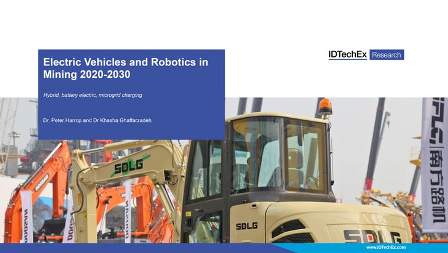Electrics and robotics squares the circle of seeking a wider variety of depleting materials in nastier, more remote places from the seafloor to four kilometres underground, up remote mountains and later outer space. Zero-emission microgrids on-site, sensors everywhere and new information and communications technology lubricate the process.
Mining embraces about 1500 large mines yielding metal-bearing material, diamonds and coal, down to tens of thousands of smaller sites such as gravel pits and marble quarries. Despite these greater challenges, mine operators must improve safety, environmental and financial aspects.
The man working a tool and the static processor are replaced by vehicles but those vehicle suppliers pushing only diesel-alone vehicles with diesel gensets as a sideline are starting to look retro and rejected.
Unique new report
The new IDTechEx report, “Electric Vehicles and Robotics for Mining 2020-2030” shows how electric vehicles and robotics progress to the newly-arrived unmanned electrical mines. See uniquely up-to-date, penetrating analysis and forecasts of the technology and markets globally. It is for all in the mining vehicle value chain.
Many mining vehicles are among the most power-hungry EVs, yet they are located where pressure for zero-emission local electricity supply is strengthening. It is therefore futile to analyse mining electrification without addressing where that zero-emission electricity will come from, so IDTechEx does that too – zero-emission microgrids on-site, increasingly multi-mode and transportable.
This 280-page report has an “Executive Summary and Conclusions” sufficient in itself because it gives ten-year forecasts in five categories, six key market drivers in detail and infograms of the mines of the future and the many new challenges. See 20 key conclusions grouped by industry, regional and technological. Mining CapEx content and trend is clarified by new infograms.
Development timeline, patent trend and progress 2020-2040 to price parity with diesel by vehicle type are graphed. The “Introduction” then scopes mining basics, leading miners and new challenges, threats and incentives, the mining equipment market and what is and is not an electric vehicle. Here are powertrain options emerging, huge scope for vehicle simplification, emissions data and targets, future types of mine, progress to electrification and unmanned mines.
Battery electric BEV mining vehicles
Chapter 3 brings it to life with profiles and products in “Mining BEV Appraisal: 23 Manufacturers”. See SOFT reports on leaders, executive responses, latest products. Chapter 4 introduces six key enabling technologies and their future for mining electric vehicles, pure electric and hybrid with a ten-year roadmap.
See electric motor options that work inversely as generators for hybrid and full electric, with examples. Electric traction is more even, controllable, faster responding and stronger from start. Motors are key to achieving long-range/ endurance and best performance. Traction battery systems include battery charging and advances to 2030. Why have supercapacitors come center stage in mining vehicles? Learn power electronics proliferation and extension to solar bodywork, including microgrid trucks.
Making clean electricity on-site
Chapter 5 “Energy Independent, Zero Emission Mines”, includes the new transportable, lower-intermittency options of open-sea wave and tidal power, river power and airborne wind energy to supplement or replace today’s battery solar and wind turbines.
Robotics resurgent
A seventh key technology – Autonomy – is important enough to have a Chapter 6 and 7. Chapter 6 is “Autonomous and Remotely Operated Mining Vehicles in Action”, and Chapter 7 is “Autonomy Components and Integration” – lidar, radar, ultrasound, sensor fusion.





